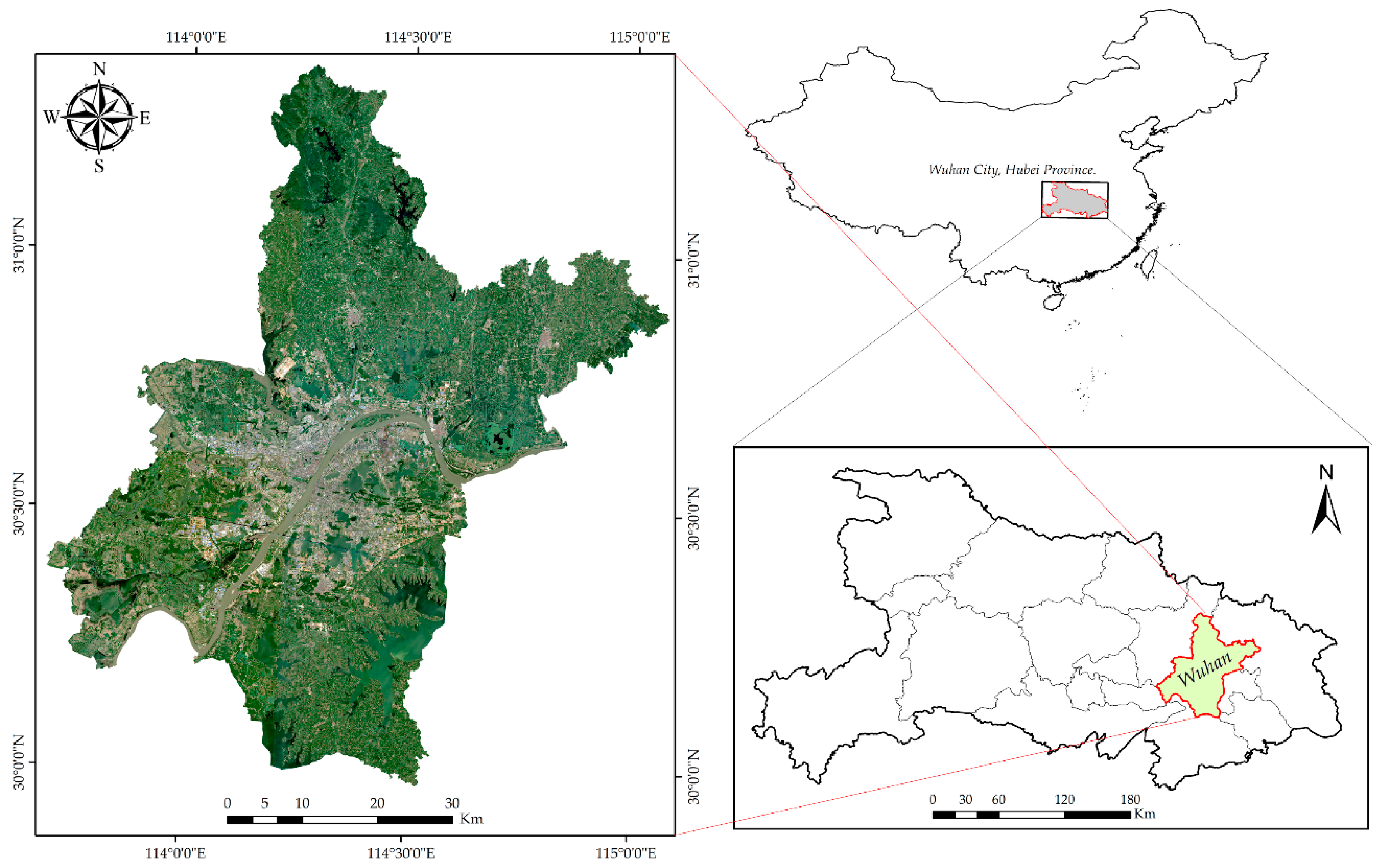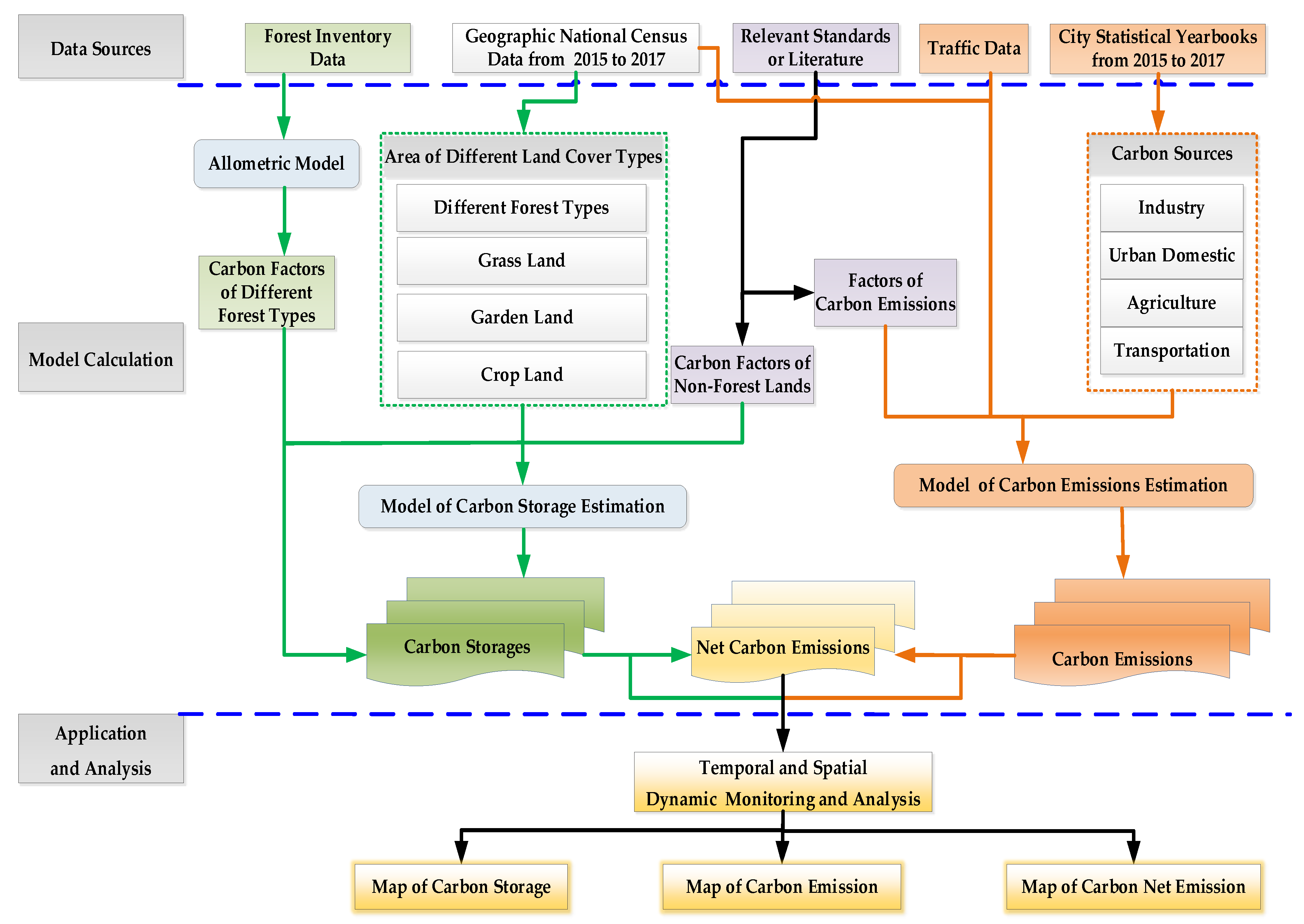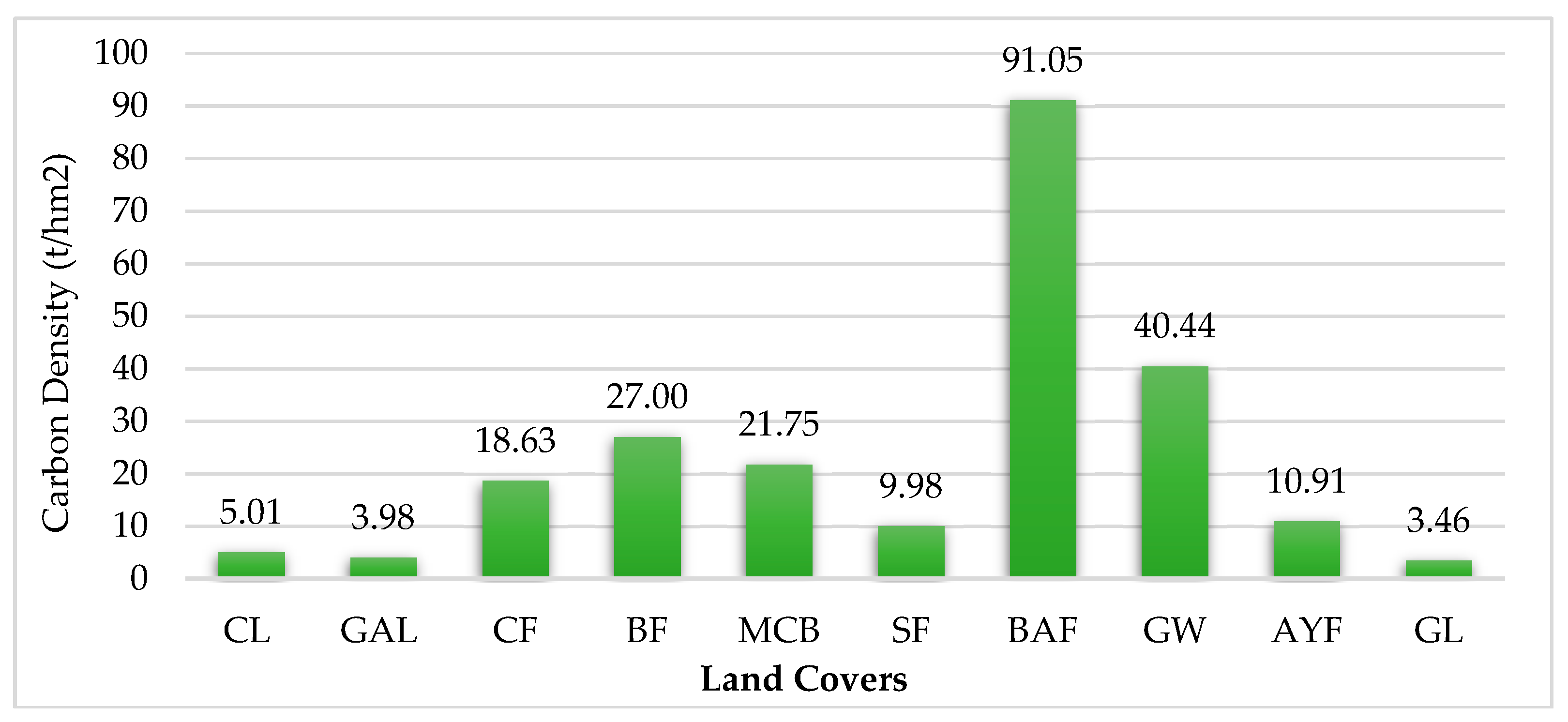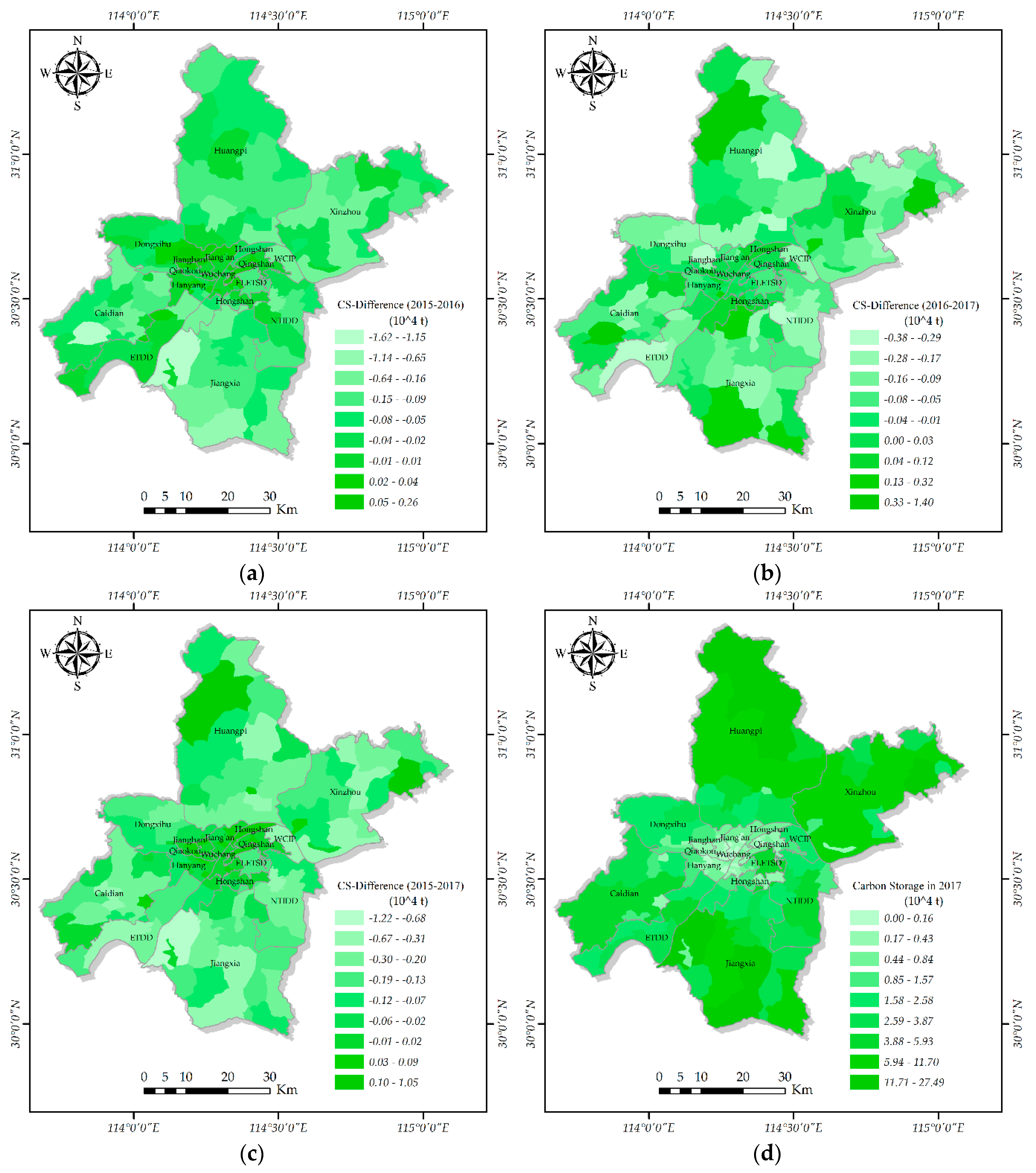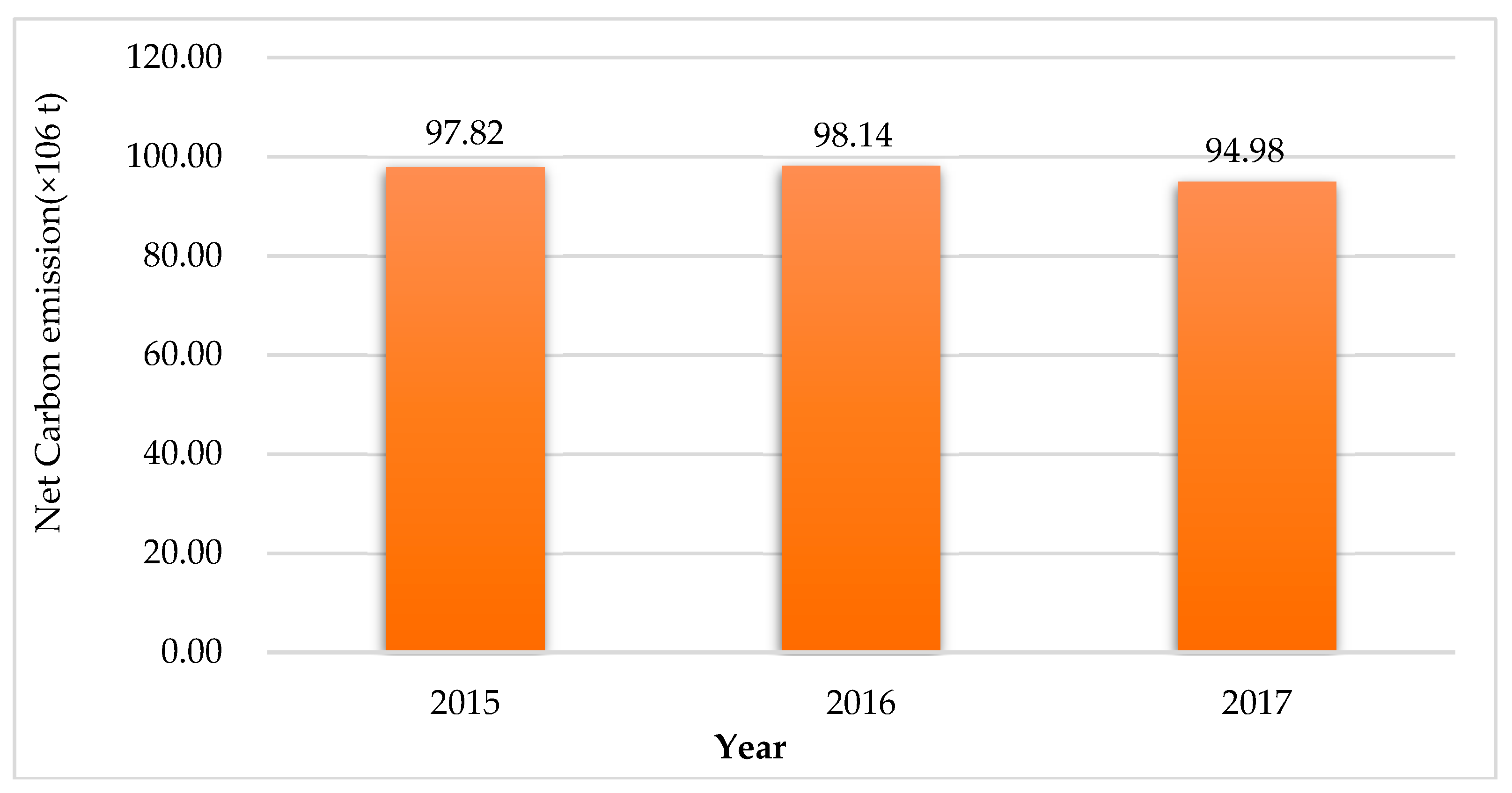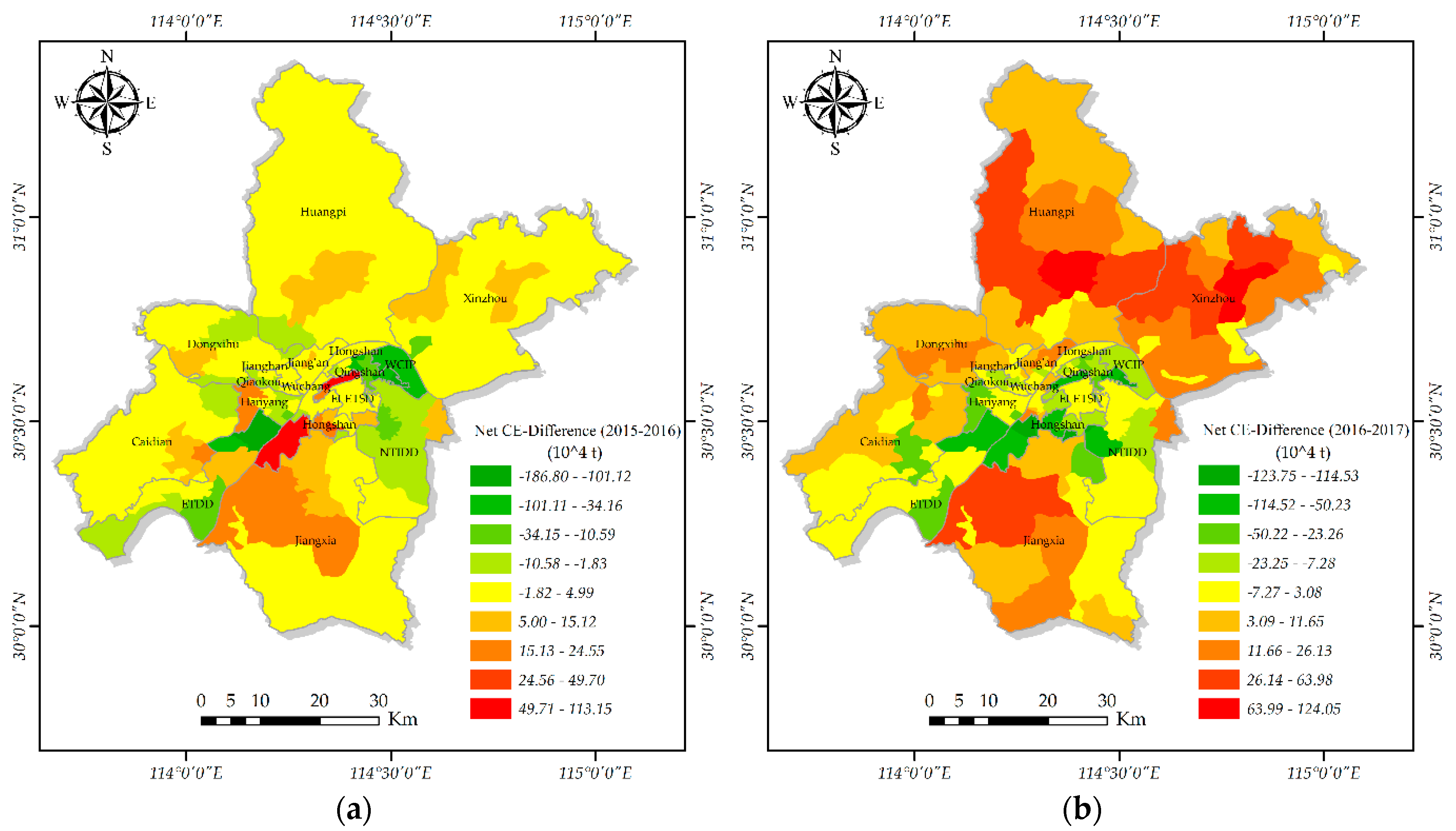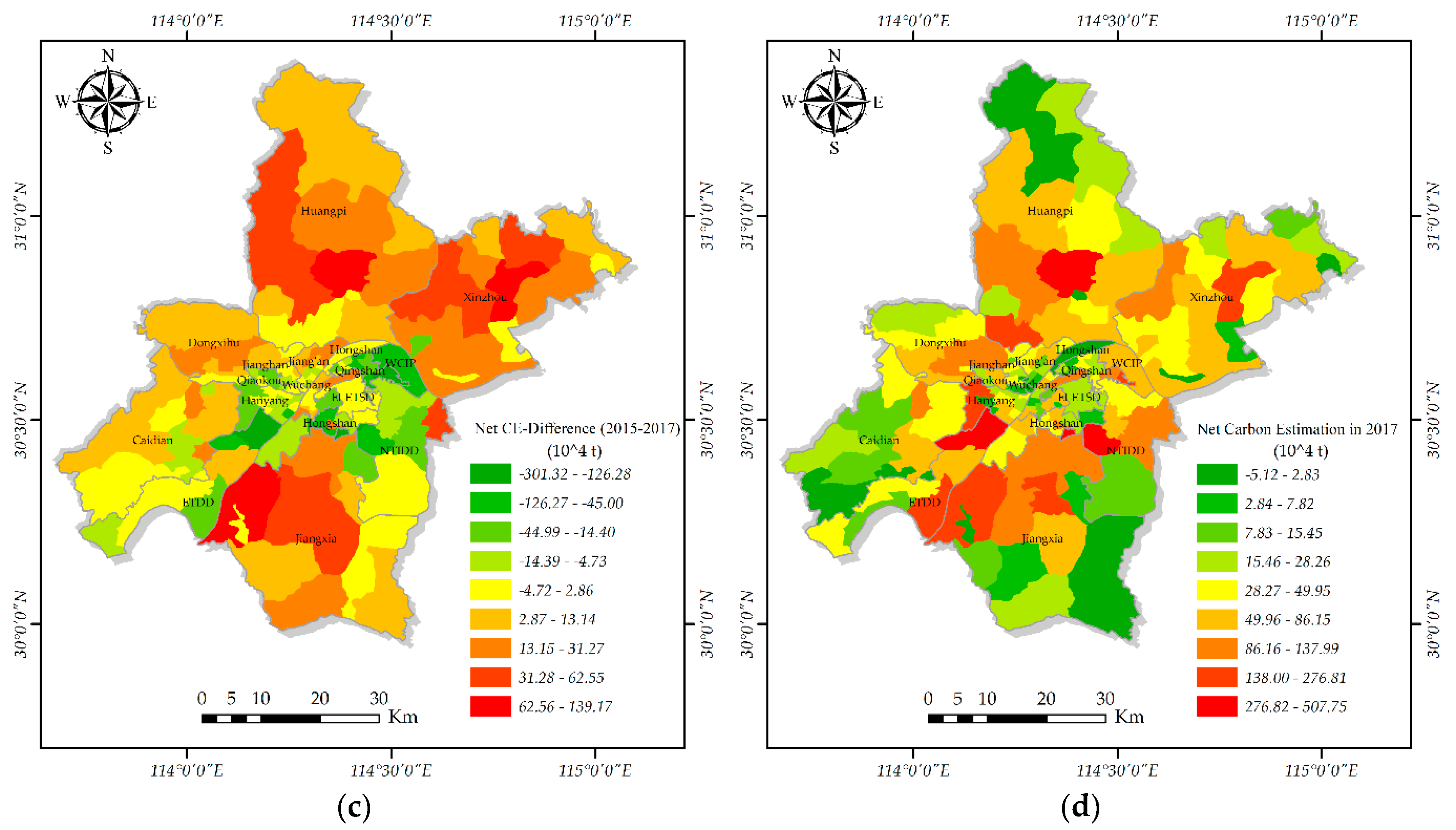1. Introduction
The C40 Large Cities Climate Leadership Group reported that 80% of the global anthropogenic greenhouse gases, which are mainly composed of carbon dioxide (CO
2), are emitted from cities [
1]. These cities are often characterized by high concentrations of population, vehicles, energy consumption, and industries. The coal energy consumption of cities accounts for 76% of the global total coal consumption, even though their coverage is less than 1% of the total area of the Earth [
2]. The reduction in the CO
2 emissions from urban systems is, therefore, essential for the reduction in global greenhouse gas concentrations. Currently, two major internationally recognized methods for controlling the continuous increase in atmospheric CO
2 concentrations have been proposed [
3]. The first is to reduce greenhouse gas emissions, and in particular, energy consumption by improving energy efficiency and developing alternative energy sources [
4,
5]. The second is to increase greenhouse gas absorption and fixation through biological measures, such as afforestation and reforestation [
6,
7,
8,
9]. Therefore, monitoring the spatial and temporal changes in carbon emissions and carbon storage (CECS) in urban ecosystems is important for governments that are engaged in decision-making processes for low carbon cities.
Land cover changes are considered to have the greatest impact on regional carbon storage and carbon emissions [
1]. In 2013, China launched the “Geographical Conditions Monitoring (GCM)” national project, which involves the dynamic monitoring of the territory of the country [
10]. Geographic National Census Data (GNCD) is the product of the GCM national project, which can be used to map CECS over wide geographical areas and large time scales, significantly improving the efficiency and accuracy of the CECS estimation [
11,
12]. As a reliable, accurate, and authoritative national geographical data, GNCD has been widely used in China for the monitoring and management of forestry, agriculture, and city development [
13]. Therefore, it is necessary to develop a methodological framework for the monitoring of urban CECS based on the GNCD.
Exploring the carbon storage capacities of different vegetation types in the urban ecosystem is important for governments that are involved in the decision-making processes of low-carbon cities. Carbon storage denotes the cumulative amount of carbon that is produced by plant communities during their lifetime. The carbon pools of urban ecosystems are generally composed of forests, grasslands, gardens, and croplands, where forests represent high-quality carbon storage areas that mitigate climate change by capturing CO
2 [
14]. Using field surveys, biometric information, and remote sensing images, McPherson, et al. [
15] concluded that their method could improve the accuracy of carbon storage estimation and increase the mapping resolution of carbon storage across a region. Wylie, et al. [
16] estimated the net carbon storage per unit time of grasslands and croplands based on regression tree models, using remote sensing and bio-geophysical data, in addition to several flux towers. Their results revealed that grassland and cropland ecosystems generally performed as weak net carbon sinks, and more carbon was absorbed from the atmosphere than was released from 2000 to 2008. Zhao, et al. [
17] and Golubiewski [
18] demonstrated that the management of urban artificial vegetation could improve carbon sequestration capacity. In addition, the increase in artificial urban features is inevitably accompanied by a decrease in natural components [
19] and the fragmentation of natural landscapes [
20], both of which reduce the carbon absorption capacity and alter the carbon budget of a city.
When compared with vegetative land cover, artificial objects have higher carbon emissions and a more significant impact on urban carbon budgets [
21]. Carbon emissions are defined as any processes, activities, or mechanisms that release CO
2 into the atmosphere [
1]. Moreover, the reduction of these emission is the main method for the reducing CO
2 concentrations in the atmosphere [
22]. Several researchers have studied the impacts of urban ecosystem carbon emissions from industry, transportation, agriculture, and urban domestic regions on urban carbon budgets [
23]. In most cities, industrial energy consumption is the largest contributor of carbon emissions [
24,
25]. However, transportation in some cities is the largest contributor of carbon emissions [
26,
27]. In addition, the carbon emissions from urban domestic regions sometimes exceed those from transportation and increase with population growth and urban development [
21]. These changes in carbon emissions and geographic coverage significantly affect the carbon budgets of cities. Therefore, it is necessary to monitor the changes in carbon sources over time and over a wide region.
Throughout modern history, researchers have developed several algorithms to estimate CECS in the urban ecosystem. Currently, the internationally recognized emission factor approach, as proposed by the Intergovernmental Panel on Climate Change (IPCC) [
28], is widely used for carbon emission estimations. Several studies have performed source attribution of carbon emissions and assessed the contribution of different emission sources [
29,
30,
31] using the emission factor approach. With respect to the carbon storage estimation, the coefficient method based on the average carbon content and geographic coverage information was proposed by the IPCC and it has been widely recognized by international scholars [
28]. Zhang, Huang, and Luo [
1] calculated the carbon storage of forests, pasturelands, and crop yields in Shenzhen based on the coefficient method. The authors concluded that urban expansion and forest reduction are the main reasons for the observed reduction in carbon sinks. To date, the main challenge of this analysis is the lack of accurate, up-to-date, and spatially explicit carbon estimations for the entire urban landscapes [
14]. The method of field observations using a limited number of plots may result in significant sampling errors and high uncertainties in carbon estimations [
15,
32]. Houghton, et al. [
33] estimated carbon emissions using land use and land-cover change data, but the historic land-use data sets were constructed based on aggregated, non-spatial data reported in national and international statistics. Brovkin, et al. [
34] explored differences in climate and land-atmosphere fluxes between ensemble averages of simulations with and without land-use changes with a spatial resolution of 0.5° × 0.5° by the end of the 21st century. In this study, the annually updated GNCD that was produced by multiple-source remote sensing data with a resolution higher than 1 m [
35] achieved a seamless full-coverage of the national geographic survey data, allowing for the realization of high-precision space monitoring of CECS. In this study, the spatial distribution and changes in urban carbon budgets on the level of the 181 administrative divisions based on GNCD was mapped, and a commonly applied demonstration for long-term dynamic monitoring of the carbon budget in urban ecosystems was provided. The aim of this study was (1) to estimate the carbon storage of different vegetation types and evaluate their carbon storage capacities; (2) to estimate the carbon emissions from industry, agricultural production, urban domestic regions, and transportation using the emission-factor model; and, (3) to map and analyze the spatiotemporal changes of carbon emissions, carbon storage, and net carbon emissions based on urban administrative divisions.
6. Conclusions
In this study, a framework was developed to estimate carbon emissions, carbon storage, and associate spatiotemporal changes in the urban ecosystem. The GNCD combined with factors affecting carbon emissions and carbon storage was successfully used to obtain the temporal and spatial carbon budget changes in an urban setting. The methods for estimating carbon storage and inventorial carbon emission factors provided by the IPCC guidelines for national greenhouse gas inventories in 2006 can be easily applied to other cities. Urban land use changes and carbon dynamics are important for the global carbon cycle [
59]. The land use change data can be obtained from the annually updated GNCD and it offers a possibility for estimation of a carbon budget at the national or large region scale.
Studies regarding the carbon budget of urban regions can offer significant insights for governments that are engaged in decision-making processes with respect to the urban carbon cycle, given that the growth of the population and economy in urban ecosystems has a significant effect on the CECS. Understanding the balance between carbon sources and carbon pools in urban ecosystems can offer insights into mitigation of the impact of CO2 in the atmosphere. The urban carbon cycle, the carbon storage abilities of different vegetation, and changes in land use are complicated. A significant amount of future studies will be required to improve the estimation results. In this study, the carbon budget monitoring-time was short, given that the newly created GNCD was completed in 2015. With the accumulated GNCD for each year, the annual CECS in cities or blocks can be monitored with high-precision and at a small-scale. In addition, only the main carbon sources and carbon pools of Wuhan were considered in this study, and the contribution of other carbon sources and storages, such as human respiration, soil, and water, were not investigated. By considering carbon budgets more comprehensively, a more accurate estimation can be mapped.
